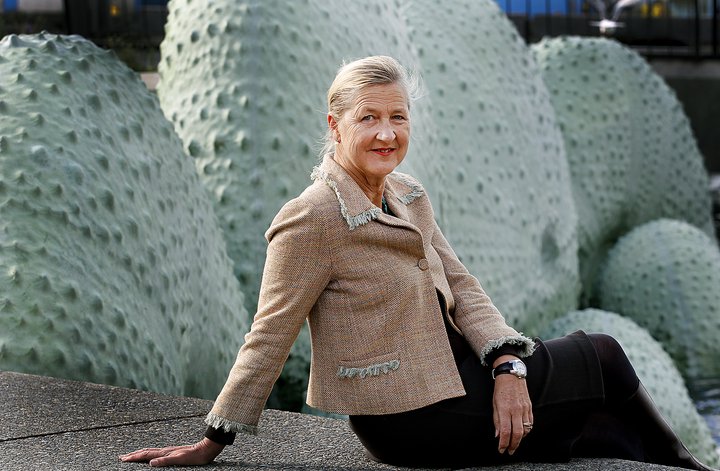30 August 2023
Sue Elliott is one of the masterminds behind the Public Art Heritage website that launched recently. With close to 400 publicly accessible artworks across Aotearoa listed, it has been a massive research project for Sue and her co-director Dr Bronwyn Holloway-Smith. The ongoing project has been designed to ensure future generations of New Zealanders have awareness of and access to these cultural treasures, and an understanding of what has already been lost.
I met Sue for a coffee to talk about the site, its purpose and the huge amount of documentation and research yet to be completed.
You can explore the site for yourself here.

The site is beautiful and so comprehensive! How long did it take to put together?
It’s been a rather torturous journey to get to this point. It started out as another project which was run by my co-director, Bron Holloway-Smith when she discovered an E. Mervyn Taylor mural that was stored in a carboard box and she began searching for other public artworks by him. A lot were gone, a lot were hidden and the search for his works became a project for the 130th anniversary of the College of Creative Arts up at Massey University Wellington. At that point I was asked if I could help Bron. Through that project people were endlessly getting in touch with us and saying, ‘oh, do you know about this work’. So, we started an informal registry and that was about six years ago.
In 2018 the wider project grew when we partnered with the Manatū Taonga Ministry for Culture and Heritage (MCH). With them we held workshops in Auckland and Wellington, but included Christchurch and Dunedin, to come up with definitions of what is public art? And what does publicly accessible mean?
In partnership with the Ministry, we also wrote a letter to all the councils throughout New Zealand asking if they had a list of their public works of art and could they share them. That took the register we had at that time up to about 1000 works.
We were also researching other artists working in the public space during the 20th Century. Public Art Heritage Aotearoa then took to the road. We received research money from Massey University to go on road trips to document works we knew of, and find those we didn’t through local knowledge.
Two years ago we received further funding from the MCH’s Cultural Sector Innovation fund to establish the register and provide information on these 20th century public artworks and their artists. That is how the website came about. Most importantly, there was a real need for that. So many of these works of 20th century art have already been lost or destroyed or painted over or taken to the tip. It’s incredibly sad. Everyone - the local bodies, the artists, the owners - have said this is a fantastic project and really supported it.
We launched with 380 artworks on the website which we’ve audited and photographed and got such great feedback from all these people going ‘yes, absolutely, that’s our work and do you know about...’ And so it’s continuing to grow.. These works tell a cultural story and equally a social one.
After the Second World War there was a building boom and there was a real drive to give people a better community and public art was a way to do that. Many of the government buildings from that time had significant artworks put into them, along with the commissioning by big corporates, the oil companies, the banks, schools, and other public spaces or areas.
Alongside that, there was the modernist movement where Māori artists too were putting artworks in public spaces away from marae, using new materials, and telling their stories, and expressing themselves in different ways. So you’ve got great artists such as Ralph Hotere, Cliff Whiting, John Hovell and Paratene Matchitt working in public spaces throughout New Zealand. If you go onto the website you’ll see there’s a whole plethora of 20th century artists, artists that will be familiar to people, but working in public spaces and in ways they might not expect. Like Colin McCahon’s stained glass windows.
It has been a real journey of discovery and our aim is to document as well as promote awareness, of these works which will help in protecting them. And equally a call out to people to find out what’s in their town that we might not be aware of.
Did you discover any new works or new artists while you were on this journey?
Lots that I didn’t know of or wasn’t aware of. I’d have to say my Taj Mahal moment – you know if you are lucky enough to see the Taj Mahal, for the first time it takes your breath away – were the Michael Smithers works in New Plymouth. They’re just magnificent works. Sadly, there were originally three, but there are still two outstanding murals there in St Joseph’s Church.
Out of all the pieces you’ve documented and seen, do you have a favourite?
It’s like being asked which is my favourite work as Chair of the Wellington Sculpture Trust! It’s very hard to answer. I think a big part of what we’re doing, and what we do with the Sculpture Trust – is the site- specificity of the works, so it’s hard to say. There are lots of works I love. Surprising for me were the Michael Smithers because I didn’t know of those, but I often like artworks because of where they are and how they talk to their space or their community.
There are lots of works I love, but equally, there are a lot of works I don’t personally like at all. But they are there for their communities and they’re significant to the region or the town or the city and that I love. We’re not trying to be the arbiters of good taste here. We’re documenting them because they are public, and because many are at risk, and trying to find out as much as we can about them.
Not just the ones that are still there, but also the ones that have been lost. A great example in Wellington that we’re trying to help with is the Roy Cowan at 109 Featherston Street. It’s behind a wall and the building has earthquake strengthening issues and is going to be pulled down. We’re trying to save the Roy Cowan. It’s a full wall of his work.
It’s been done before. There was a Jim Allen work at ICI House and the Council and the Sculpture Trust worked together with the demolition crew to save the work and have it taken away, piece by piece. The hope is that it will go into the new building going up on the same site. The question is whether we can do the same for the Roy Cowan.
There’s another one that’s a good example of works that have been saved and restored, by P. E. Leeming; it was in a building on the Terrace and commissioned by NAC, the National Airways Corporation. When that building was torn down, the work was saved and sent to Auckland. It’s now come back to Wellington and in a building two doors down from where it was originally.
Do you plan to keep the website updated as you find new works or new artworks are commissioned?
Absolutely! We’ve already got 900 works on our yet-to-be-audited list and now that we’ve got the website up, we’re working our way through that. Bron and I have set up a charitable trust to continue the work. The money from MCH was for the work up to this point, to get the website launched.
How many important pieces of art do you think have been lost over the years, to construction or people just not knowing what they have?
We haven’t quantified that. We could, from the ones we know about. But there are so many we don’t know about, ones that have just gone. That’s why it’s important that we list these on the website. We’re going to list the works we know about that have been lost or destroyed.
Is there anything else you’d like to tell me about the site? Is there any way people can get involved?
We need money, for starters, so we can carry on our work... Equally, a call to people to go into the website; through that you can contact us if there’s a work you know about that maybe we don’t. An example is – it’s gone now – there was a Russell Clarke in what was Shell House on the Terrace. When Transpower went in there they wanted to get rid of it, and thought about putting a wall in front of it, but it was destroyed and we only know about that through somebody who was on the Board at the time.
People who work for banks, or oil companies, or schools – we’d like to know about where these artworks went. They might not have been destroyed, but we just don’t know what happened to them, and someone else will.
Thank you, Sue! What an amazing project. I was particularly interested in the ones in places like hospital corridors. People probably walk past them every day and don’t even know that they’re significant.
That’s why one of the things we’re doing on the protection side is working with owners to have plaques put next to the works. People don’t know what they don’t know, so it gives people a chance to stop and look at the plaque and look at the work. Hopefully that will build both awareness and appreciation.


